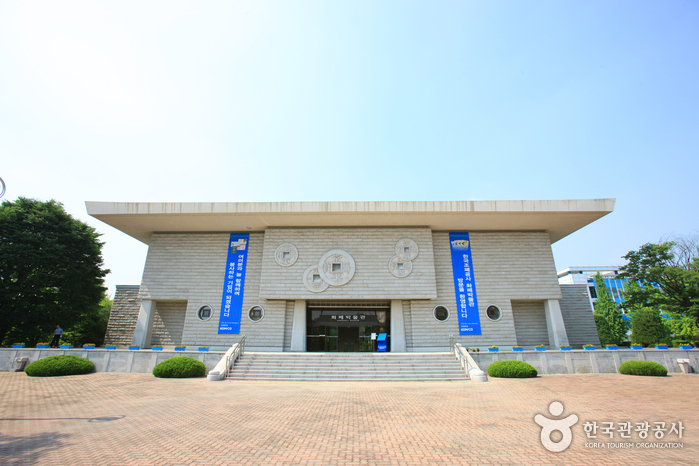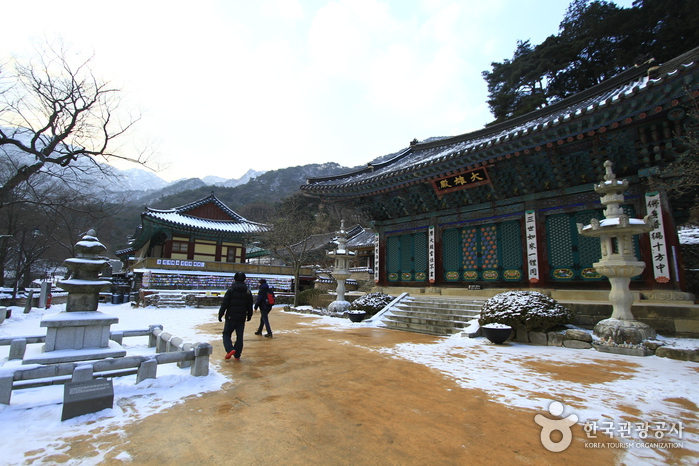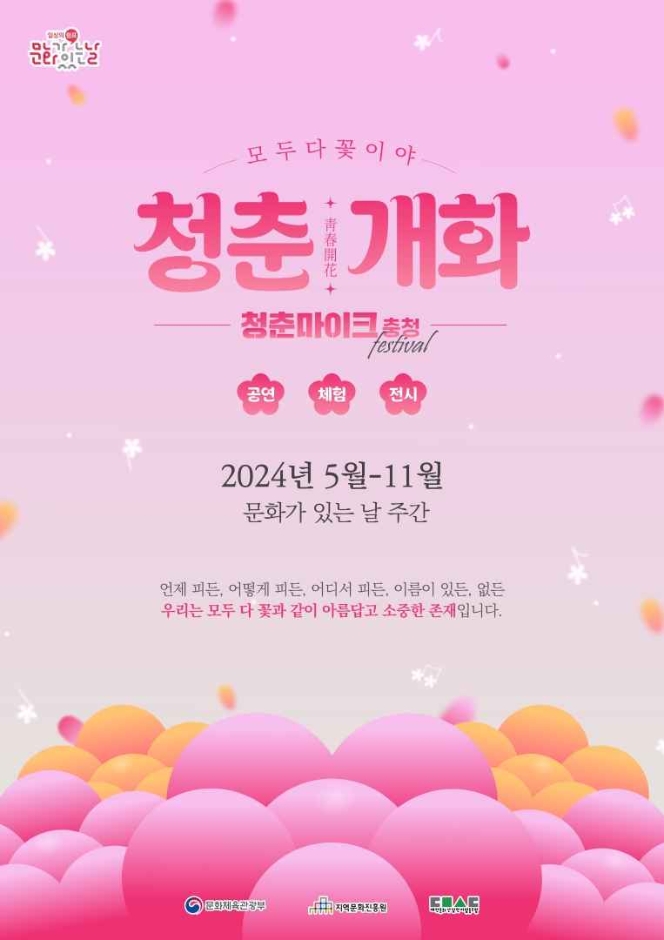Cheongju Sutbul Galbi (청주숯불갈비)
16.2Km 2024-03-25
422 Taeseongtabyeon-ro, Gangnae-myeon, Heungdeok-gu, Cheongju-si, Chungcheongbuk-do
043-232-2992
Opened in 1985, the restaurant specializes in charcoal-grilled galbi. Their signature dish, the dwaeji galbijjim set menu, features braised pork galbi, doenjang jjigae (soybean paste stew), and gonggibap (steamed rice). Favorites also include the sutbul bulgogi set menu (charcoal-grilled bulgogi), anchangsal (grilled thin skirt), saeng deungsim (grilled sirloin), and galbisal gui (grilled boneless galbi). Additionally, they offer a seasonal selection of nicely presented side dishes with homegrown vegetables. The in-house made soybean paste, crafted from their own soybeans, is notably flavorful.
Himart - Yuseong Branch [Tax Refund Shop] (하이마트 유성점)
16.2Km 2024-04-18
808, Yuseong-daero, Yuseong-gu, Daejeon
-
Jeongsimhwa Hall of Jeongsimhwa International Cultural Center at Chungnam National University (충남대학교 정심화국제문화회관)
16.2Km 2025-01-09
99, Daehak-ro, Yuseong-gu, Daejeon
+82-42-821-8080
The Jeongsimhwa International Cultural Center is the large building on the right, just past the gate of Chungnam National University.
‘Jeongsimhwa’ is the Buddhist name of Ms. Lee Bok-Soon, who donated her lifetime savings (a total of five billion won) to the university back in 1990. She had earned the money over the course of many years by selling gimbap (rice rolled in seaweed), which currently sells for only 1,000 or 2,000 won a roll.
The cultural center was built in commemoration of the late Ms. Lee. After a series of setbacks and through the effort of many helping hands, construction was finally completed in 2000. The Jeongsimhwa Hall at the center has 1,817 seats and is used for concerts, performances, and other large-scale events. Baekma Hall (450 seats) and Daedeok Hall (200 seats) are used primarily for seminars. For visitors’ convenience, the Jeongsimhwa International Cultural Center has a parking area with space for up to 268 cars.
Coffee Interview (커피인터뷰)
16.2Km 2024-02-28
25-3 Hanbat-daero 371beon-gil, Yuseong-gu, Daejeon
Coffee Interview is a café celebrated for its sensuous interior. It boasts a wide selection of beverages and desserts, with einspänner and bam latte (chestnut latte) as their signature items. The café's garden and terrace contribute to an ambiance that evokes the sense of embarking on a forest journey, making it a popular destination for those seeking to immerse themselves in this unique atmosphere.
Currency Museum of Korea (화폐박물관)
16.3Km 2019-03-18
80-67, Gwahak-ro, Yuseong-gu, Daejeon
+82-42-870-1000
The Currency Museum of Korea is the first museum in Korea to be dedicated solely to modern and ancient currencies. The museum (est. 1988) is operated by the Mint Corporation of Korea as part of its non-profit public services and is open to visitors free of charge with a view of increasing public knowledge of the nation’s currency. The museum features a total of 120,000 pieces including: coins currently in use both in Korea and overseas; coins from modern times (from the Late Joseon Dynasty until today); 80 types of commemorative coins; 88 types of ‘special money’; postage stamps, and other materials.
Exhibition Room 1 presents a wide selection of coins from both ancient eras and modern times, with many of the coins dating back to the Goryeo and Joseon dynasties. Coins on display in this room include Geonwonjungbo (996), the first coin ever minted in Korea; Haedongwonbo (1097); and Sangpyeongtongbo, the most widely used coin during the Joseon Dynasty. Other displays include commemorative coins from past Olympics, special coins, charms, amulets and Lydian currency, the world’s first-ever alloy coin minted around 670 BC.
Exhibition Room 2 (Exhibition of Bills) displays a wide variety of bills by era as well as information detailing the production process of a banknote (from the manufacturing of the paper used to the finished product). Exhibition Room 3 shows how authorities spot counterfeit money while Exhibition Room 4 has a wide selection of stamps, medals, and currencies from over 120 different countries around the world including Russia and North Korea.
Gongju Donghaksa Temple (동학사(공주))
16.3Km 2020-03-16
462, Donghaksa 1-ro, Gongju-si, Chungcheongnam-do
+82-42-825-2570
Located in the east valley of Gyeryongsan Mountain in Hakbong-ri, Banpo-myeon, Gongju, Donghaksa Temple is the first and the oldest existing academic institute for female monks. Home to about 150 monks who study and practice Buddhism, the temple is the most visited spot on all of Gyerongsan Mountain due to its history, convenient location, and visitor facilities.
The elegant structure of the temple is x_heighted by the majestic view of Munpilbong Peak to its front. In the spring, many visitors come to the temple to see the cherry blossom tunnel, a 3 kilometer pathway from Bakjeongja three-way intersection to Donghaksa Temple. Every year since 1993 the temple has also been the venue of the Donghaksa Spring Flower Festival.
Nogwon Ganjang Gejang (녹원간장게장)
16.4Km 2024-03-20
544 Daedeok-daero, Yuseong-gu, Daejeon
Nogwon Ganjang Gejang is a ganjang gejang (soy sauce marinated crab) specialty restaurant situated near the National Science Museum in Daejeon. Their standout offering is ganjang gejang jeongsik (soy sauce marinated crab set menu). This dish, created by marinating blue crabs in soy sauce, is renowned for its rich aroma and flavor. It pairs exceptionally well with rice, earning it the playful nickname "Bap-doduk (rice thief)," as it tempts diners to finish an entire bowl of rice with ease.
Cheongchun Mic Chungcheong Region (문화가 있는 날 청춘마이크 충청권)
16.5Km 2024-07-25
46 Yuseong-daero 740beon-gil, Yuseong-gu, Daejeon
+82-42-825-6781
Cheongchun Mic is a street performance to promote local youth, hosted by the Ministry of Culture, Sports and Tourism. The performance, created by young artists, showcases the sociatal issues young people face these days, while creating an opportunity to overcome these challenges through support of the community.
CU - Jangdae Jungang Branch [Tax Refund Shop] (cu장대중앙점)
16.5Km 2024-06-26
47, Munhwawon-ro 6beon-gil, Yuseong-gu, Daejeon
-
Hanbang Samgyetang (한방삼계탕)
16.5Km 2024-02-15
43 Jeonmin-ro 14beon-gil, Yuseong-gu, Daejeon
Hanbang Samgyetang is known for its hanbang samgyetang (ginseng chicken soup with medicinal herbs). This nutritious dish consists of chicken slowly cooked with a variety of healthy medicinal herbs, resulting in tender meat and a rich yet light broth. The meal is complemented with a ginseng liquor aperitif and standard side dishes, including kkakdugi (diced radish kimchi) and cabbage kimchi.

![Himart - Yuseong Branch [Tax Refund Shop] (하이마트 유성점)](http://tong.visitkorea.or.kr/cms/resource/42/2883542_image2_1.jpg)




 English
English
 한국어
한국어 日本語
日本語 中文(简体)
中文(简体) Deutsch
Deutsch Français
Français Español
Español Русский
Русский